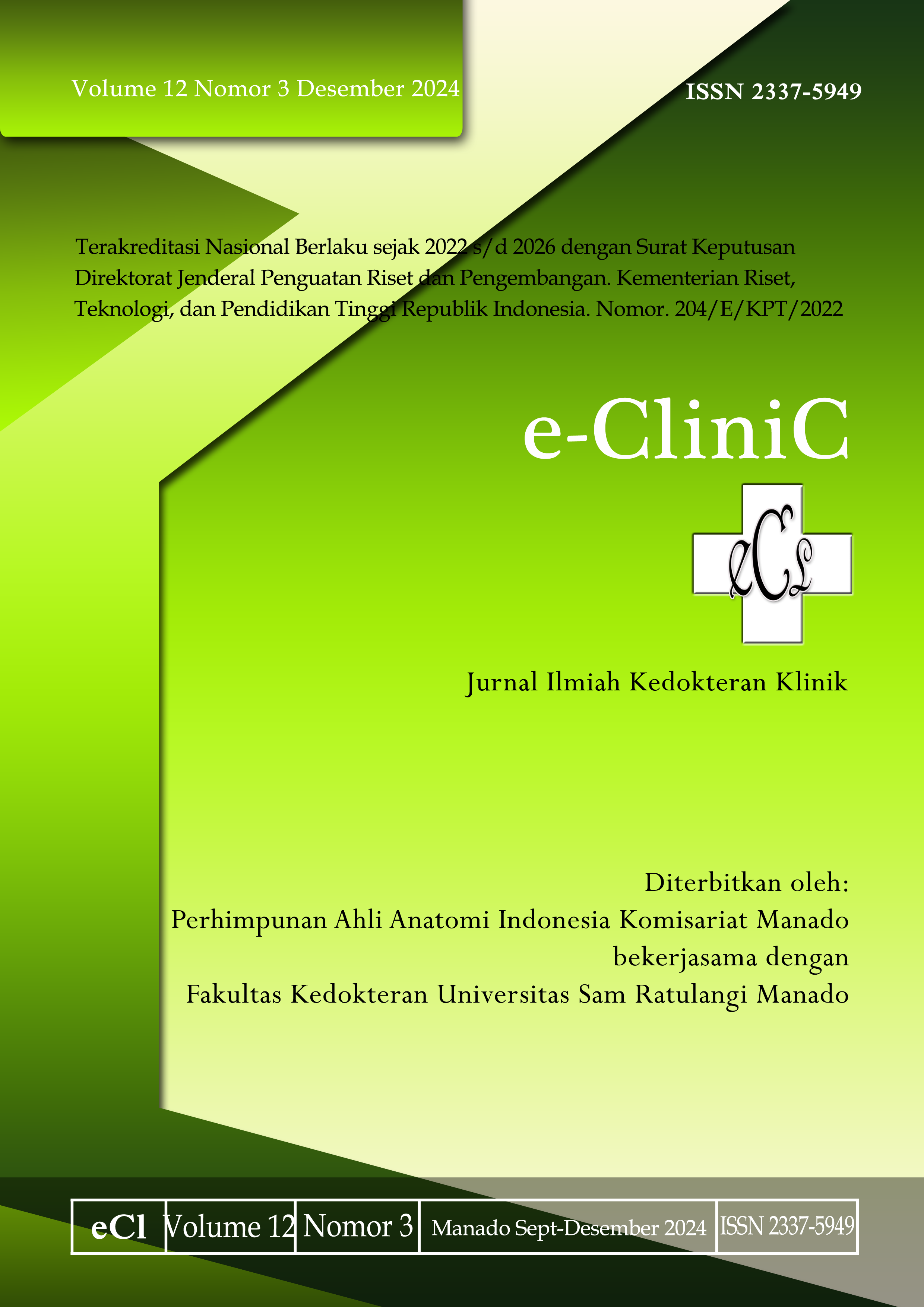Profil Penyakit Jantung Bawaan di Bagian Ilmu Kesehatan Anak RSUP Prof. Dr. R. D. Kandou Manado Periode September 2022 – Agustus 2023
DOI:
https://doi.org/10.35790/ecl.v12i3.55352Abstract
Abstract: Congenital heart disease (CHD) is a congenital heart defect that occurs during the heart development period of 3-8 weeks gestational age. This disease is divided into two categories, non-cyanotic CHD and cyanotic CHD. This study aimed to determine the profile of CHD in the Pediatric Department of Prof. Dr. R. D. Kandou Hospital Manado from September 2022 to August 2023. This was a retrospective and descriptive study using patients’ medical records during the period September 2022 - August 2023. The results obtained 94 patients with a mean age of 3.6 years, most of them were >5 years old (35.1%), consisting of males (53.2%) and females (46.8%). Asianotic CHD (78.7%) was the most common CHD found, and the majority of patients had good nutritional status (59.6%). In conclusion, congenital heart disease in children is most common in males, with asianotic type, and good nutritional status.
Keywords: congenital heart disease; pediatric patients
Abstrak: Penyakit jantung bawaan (PJB) merupakan kelainan sejak lahir pada jantung yang terjadi saat masa perkembangan jantung usia gestasi 3-8 minggu. Penyakit ini terbagi atas dua kategori yaitu PJB non sianotik dan PJB sianotik. Penelitian ini bertujuan untuk mengetahui profil PJB di Bagian Ilmu Kesehatan Anak RSUP Prof. Dr. R. D. Kandou Manado periode September 2022 – Agustus 2023. Penelitian ini menggunakan metode deskriptif retrospektif dengan menggunakan rekam medik pasien selama periode September 2022 – Agustus 2023. Hasil penelitian mendapatkan 94 pasien PJB dengan rerata usia 3,6 tahun, terbanyak pada sebaran usia >5 tahun (35,1%), jenis kelamin laki-laki (53,2%) dan perempuan (46,8%), Penyakit jantung bawaan asianotik (78,7%) merupakan kategori PJB terbanyak, dan mayoritas pasien memiliki status gizi baik (59,6%). Simpulan penelitian ini ialah penyakit jantung bawaan pada anak terbanyak berjenis kelamin laki-laki, jenis asianotik, dan memiliki status gizi baik.
Kata kunci: penyakit jantung bawaan; pasien anak
References
Linde D, Konings EEM, Slager MA, Witsenburg M, Helbing WA, Takkenberg JJM, et al. Birth prevalence of congenital heart disease worldwide: A systematic review and meta-analysis. J Am Coll Cardiol. 2011;58(21):2241–7. Doi: 10.1016/j.jacc.2011.08.025
Liu Y, Chen S, Zühlke L, Black GC, Choy MK, Li N, et al. Global birth prevalence of congenital heart defects 1970-2017: Updated systematic review and meta-analysis of 260 studies. Int J Epidemiol. 2019;48(2):455–63. Doi: 10.1093/ije/dyz009
Wu W, He J, Shao X. Incidence and mortality trend of congenital heart disease at the global, regional, and national level, 1990-2017. Med (United States). 2020;99(23). Doi: 10.1097/MD.0000000000020593
Kelompok Kerja Kardiologi Pediatrik dan Penyakit Jantung Bawaan Perhimpunan Dokter Spesialis Kardiovaskular Indonesia. Panduan Tatalaksana Penyakit Jantung Bawaan Dewasa (PJBD). 2020.
Hariyanto D. Profil Penyakit Jantung Bawaan di Instalasi Rawat Inap Anak RSUP Dr. M. Djamil Padang Januari 2008 - Desember 2011. Sari Pediatr. 2012;14(3):152–7. Doi: http://dx.doi.org/10.14238/sp14.3.2012
Umboh A, Rompies R, Umboh V. Hubungan status gizi dan anemia dengan penyakit jantung bawaan pada anak. Sari Pediatr. 2022;23(6):395. Doi: http://dx.doi.org/10.14238/sp23.6.2022.395-401
Aaronson PI WJ. At a glance: Sistem kardiovaskular. Edisi ketiga. Jakarta: Penerbit Erlangga; 2007.
Djer MM, Madiyono B. Tatalaksana Penyakit Jantung Bawaan. Sari Pediatr. 2016;2(3):155. Doi: http://dx.doi.org/10.14238/sp2.3.2000.155-62
Willim HA, Cristianto, Supit AI. Critical Congenital Heart Disease in Newborn: Early Detection, Diagnosis, and Management. Biosci Med J Biomed Transl Res. 2020;5(1):107–16. Doi: https://doi.org/10.32539/bsm. v5i1.180
Cameron P, Browne G, Mitra B, Dalziel S, Craig S. Textbook of Pediatric Emergency Medicine. Fourth Edition. Elsevier.
Hermawan BJ, Hariyanto D, Aprilia D. Profil Penyakit Penyakit Jantung Bawaan Di Instalasi Rawat Inap Anak Rsup Dr. M. Djamil Padang Periode Januari 2013 – Desember 2015. J Kesehat Andalas. 2018;7(1):142. Doi: https://doi.org/10.25077/jka.v7i1
Ekure EN, Bode-Thomas F, Sadoh WE, Orogade AA, Otaigbe BE, Ujunwa F, et al. Congenital Heart Defects in Nigerian Children: Preliminary Data From the National Pediatric Cardiac Registry. World J Pediatr Congenit Hear Surg. 2017;8(6):699–706. Doi: 10.1177/2150135117725457
Wanni KA, Shahzad N, Ashraf M, Ahmed K, Jan M, Rasool S. Prevalence and spectrum of congenital heart diseases in children. Hear India. 2014;2(3):76. Doi: 10.4103/2321-449X.140230
Saxena A, Mehta A, Sharma M, Salhan S, Kalaivani M, Ramakrishnan S, et al. Birth prevalence of congenital heart disease: A cross-sectional observational study from North India. Ann Pediatr Cardiol. 2016;9(3):205–9. Doi: 10.4103/0974-2069.189122
Zhang M, Wang L, Huang R, Sun C, Bao N, Xu Z. Risk factors of malnutrition in Chinese children with congenital heart defect. BMC Pediatr. 2020;20(1):1–7. Doi: https://doi.org/10.1186/s12887-020-02124-7
Wernovsky G, Anderson R, Kumar K, Redington A, Tweddel J, Tretter JT. Anderson’s Pediatric Cardiology. Fourth Edi. Philadelphia P, editor. Elsevier; 2020.
Hassan BA, Albanna EA, Morsy SM, Siam AG, Al Shafie MM, Elsaadany HF, et al. Nutritional Status in Children with Un-Operated Congenital Heart Disease: An Egyptian Center Experience. Front Pediatr. 2015;3(June):1–5. Doi: 10.3389/fped.2015.00053
Centeno-Malfaz F, Moráis-López A, Caro-Barri A, Peña-Quintana L, Gil-Villanueva N, Redecillas-Ferreiro S, et al. Nutrition in congenital heart disease: Consensus document. An Pediatr. 2023;98(5):373–83. Doi: 10.1016/j.anpede.2023.02.022
Downloads
Published
How to Cite
Issue
Section
License
Copyright (c) 2024 Aida K. Baksh, David S. Waworuntu, Adrian Umboh

This work is licensed under a Creative Commons Attribution-NonCommercial 4.0 International License.
COPYRIGHT
Authors who publish with this journal agree to the following terms:
Authors hold their copyright and grant this journal the privilege of first publication, with the work simultaneously licensed under a Creative Commons Attribution License that permits others to impart the work with an acknowledgment of the work's origin and initial publication by this journal.
Authors can enter into separate or additional contractual arrangements for the non-exclusive distribution of the journal's published version of the work (for example, post it to an institutional repository or publish it in a book), with an acknowledgment of its underlying publication in this journal.
Authors are permitted and encouraged to post their work online (for example, in institutional repositories or on their website) as it can lead to productive exchanges, as well as earlier and greater citation of the published work (See The Effect of Open Access).







